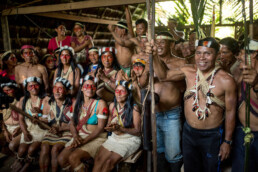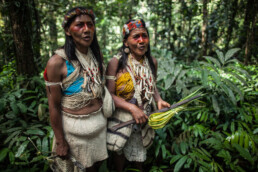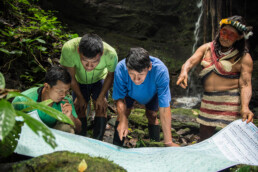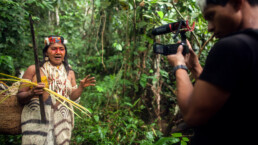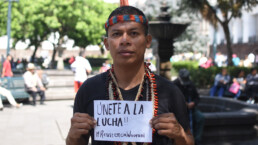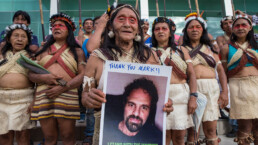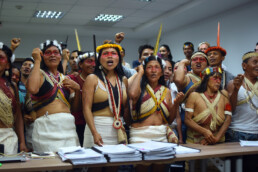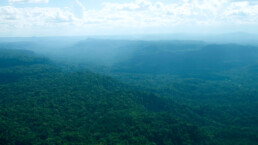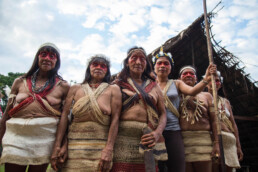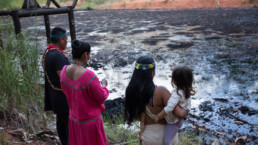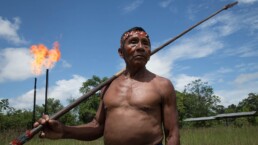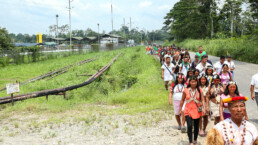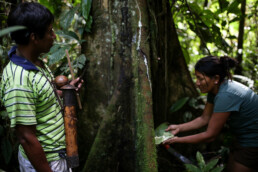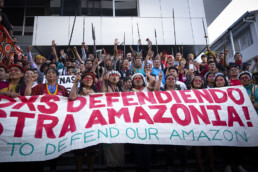8 Reasons The Landmark Ruling In Ecuador Signals Hope In The Struggle To Save Amazon Rainforest
This summer, a court in Ecuador issued a ruling with profound implications for the urgent fight to save the imperiled Amazon rainforest. The decision effectively blocked a planned government oil-auction that threatened half-a-million acres of some of the world’s most biodiverse primary rainforest. The broad outlines of the situation are sadly familiar to similar cases found throughout the Amazon region: In pursuit of foreign investment, the government sought to partner with foreign firms to develop large swaths of ecologically fragile rainforest. As is often the case, these forests were the ancestral lands of indigenous inhabitants who were not informed about — and did not approve — the arrival of industry on their territory.
The Waorani villagers-turned-plaintiffs have millennia deep roots in the region. They have seen the effects of oil blocks in other parts of the Ecuadorian Amazon, and knew that the planned auction threatened their survival and way of life. They also knew their rights: Like all indigenous peoples, they hold an internationally recognized right to informed consent when it comes to the “development” of their ancestral lands. When indigenous people fight to defend and enforce these rights, they are protecting their future and ours. The fate of the global climate hinges on empowering the indigenous peoples who help preserve nearly a quarter of the Amazon across seven nations, and who represent a powerful buffer against the destruction of a biosphere that regulates our planet’s flows of oxygen, carbon and freshwater.
Below are eight important lessons of this historic victory.
1) Healthy Cultures, Healthy Forests
The Waorani people are legendary hunter-harvesters of the southcentral Ecuadorian Amazon. For unknown centuries before their contact by missionaries in the 1960s, they lived in harmony with and preserved their rainforest home. They developed a rich culture marked by high craftsmanship and artistry, profound spirituality and a sophisticated understanding of the natural world and its complex systems of plant and animal life.
The Waorani and hundreds of other Amazonian indigenous cultures have been under enormous strain since the arrival of industry in the last century. Indeed, it is impossible to separate the physical pollution of the rainforest from the cultural disruption experienced by the people who live there. The relation between them is not causal, but cyclical: The growth of oil roads, mono-crops and mining jeopardizes indigenous peoples’ ability to survive off the land sustainably and in balance with the forest. It creates a dynamic that forces indigenous youth to abandon tradition and find work in the very industries that threaten their forest homes. The Waorani victory is important not only because it protects trees, but because it protects the culture that can continue to protect trees for centuries to come.
2) Defining the Narrative: Maps, Technology, Stories
The fate of the rainforest will be determined by how the world chooses to see it and conceive of its riches. Is the Amazon basin merely a green mass of undifferentiated land, crisscrossed by hundreds of unremarkable rivers? Is it a grid of resource concessions, notable for what’s under the ground, and convertible into currencies and value on international commodity markets? Or is the Amazon a tapestry of delicate and overlapping systems containing immeasurable biological, ecological and cultural treasures?
At their most basic level, these are competing stories, conflicting narratives, that begin with the maps that we use to represent the land. One of the ways the Waorani “won the narrative” was by using their own maps and telling their own stories. A territorial mapping project showed what the state and company maps left out — the turtle nesting grounds, the sacred sites, the ways the rivers fed the forest and each other. Through this and other tools — drone videos, testimonies, camera-trap images, even selfies — they illustrated the many ways that their culture, and everything it protected, is more precious than oil and greed. They also showed how a hunter-harvester people can leverage technology and social media on their own terms to challenge a mighty industry and capture the imagination of global civil society.
3) The Power of Legal Precedent
Rights enshrined in international laws and national constitutions are not worth their ink without enforcement. As with any laws, they are more likely to be enforced when they rest on firm precedent, locally and around the world. For too many years, the Waorani have seen the Ecuadorean government ignore their constitutional and international obligations to inform and acquire consent, and allow companies to pollute indigenous lands.
“We are Waorani and we have always lived in the Amazon rainforest. For thousands of years we have defended our territory from trespassers. Now we are fighting with our words and papers. We never knew the government wanted to extract oil from our lands. We, Pikenanis, are never going to sell our territory to the oil companies. We want to live well in our territory.”
– Memo Yahuiga Ahua Api, Pekinani (traditional leader)
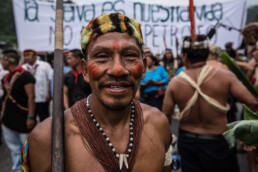
“We are Waorani and we have always lived in the Amazon rainforest. For thousands of years we have defended our territory from trespassers. Now we are fighting with our words and papers. We never knew the government wanted to extract oil from our lands. We, Pikenanis, are never going to sell our territory to the oil companies. We want to live well in our territory.”
– Memo Yahuiga Ahua Api, Pekinani (traditional leader)
Because the Waorani demanded the government respect the law and the constitution, indigenous peoples across the Amazon can now draw inspiration and tactical lessons from Waorani legal success in linking the right to self-determination to the right to free, prior, and informed consultation. Its example puts the country and the region one step further towards redefining the legal framework for indigenous rights.
Although the first battle has been won, the struggle is ongoing. The Ecuadorian government is still seeking to auction seven million acres in the country’s central rainforest to oil companies.
4) Climate Change & Interconnectedness
The Waorani victory is a victory for the climate: it keeps 500,000 acres of trees working as carbon vacuums, and prevents the pumping of millions of gallons of crude oil that would have been shipped to California for refining and distribution to gas stations across the United States. In aggregate, it is estimated that over the next ten years the Waorani victory will have avoided approximately 19.0 million metric tons of CO₂ emissions – or the equivalent of the greenhouse gases emitted from roughly 4 million passenger cars in one year.
After the oceans, the rainforests are the world’s most important carbon sinks, a sprawling continent’s worth of vegetation that absorbs and keeps carbon out of the atmosphere for hundreds of years. As the traditional inhabitants and defenders of this carbon sink, indigenous communities are the “secret weapon” in its defense, according to a growing body of research. A report by a group of leading research centers estimates that indigenous lands cover around a quarter of the world’s above-ground tropical carbon sinks.
The importance of the Amazon system extends beyond carbon. Its hydrological cycle involves more than one-fifth of the planet’s freshwater supply, and any decline in rainfall and evapotranspiration in the Amazon — the consequence of deforestation and contamination — has far-reaching effects, including drought in breadbaskets throughout the hemisphere and less river-feeding snowpack in the mountains of the pacific northwest.
5) Women in Front
The Waorani struggle involved three generations of women fighting to protect their culture, territories and sources of food and fresh water. Dozens of Waorani women participated in the court proceedings, and led the media events surrounding the hearing. They arrived bearing examples of traditional Waorani culture and craftsmanship — palm-woven baskets, clay pots and food grown in traditional gardens. When the women felt they were being disrespected by court and government officials, they halted the insults by breaking out into spontaneous song. All of this helped capture the imagination of the world with their spirit and their conviction and courage.
“This victory is a dream come true. It means that our future generations can continue to live freely in a healthy and pristine forest, with clean water and pure air. I always wanted to protect these lands for the future generations, as my ancestors did for me! It is the legacy for my grandchildren. This belongs to them!”
– Omanca Enquiri, Pekinani (traditional leader)
One of the lead plaintiffs in the case is Nemonte Nenquimo, a Waorani mother and president of the Waorani communities on the Pastaza river. “We are the caretakers of the forest and we will continue defending it as our ancestors have done for thousands of years,” Nenquimo told reporters outside the courtroom during this summer’s hearing. “As women, we are fighting for our children, for our families, for our communities and for our Mother Earth. We will never allow the oil companies to enter our territory. Our forest is not for sale and this is our decision”.
6) Protecting Rivers and Water
Life in the Amazon is lived on rivers. From fishing to bathing to providing drinking water, the rivers are the central arteries of everyday life. Because all of the rivers in the Amazon flow from or into other rivers — and are often located in floodplains — it is all but impossible to isolate or contain contamination. This is made tragically clear in the legacy of the U.S. oil company Texaco (now Chevron) which in the 1960s won a government contract to develop the region’s oil deposits. Disregarding the health of the forests and the local indigenous people, the company dumped waste and spilled oil wantonly throughout the forest and into its rivers. Many local indigenous people fell ill and died from consuming toxic material that sometimes appeared as thick sludge on the river, and other times was invisible, but no less dangerous to those who consumed it through the water, produce grown on contaminated soils, and the wider food chain. Today, many communities in eastern Ecuador cannot drink from rivers their ancestors used for countless generations. The contamination of the region is not historical, but ongoing. Though Chevron no longer operates in the region, regional and Chinese firms continue to engage in oil production at the invitation of the Ecuadorean government.
This is the crucial, local context for the Waorani victory, and explains why the villagers refused to allow further destruction of the area’s fresh water sources. Their refusal reflects a global movement — seen throughout Latin America, Africa, and Asia, all the way to Standing Rock in the U.S. — to both defend indigenous rights and lead by example toward a broader and deeper respect for nature as the sacred source of all life.
7) Wildlife and Biodiversity
It is said that the Amazon invites cliché and resists hyperbole. Indeed, it is difficult to overstate the bounty of the Amazon’s plant and animal life. Accounting for a tenth of all known species on the planet, the Amazon is an ecosystem without equal. It is also an ecosystem full of mysteries yet to be discovered. Much of the modern pharmacopeia derives from Amazonian plants, and longstanding medical mysteries may yet be solved by researching the flora of a healthy forest.
“The forest is rich and provides us with everything we need.
We are not poor, we are rich in resources and we will not allow anyone
to come and destroy our home because it is our life”
– Awane Ahua, Pekinani (traditional leader)
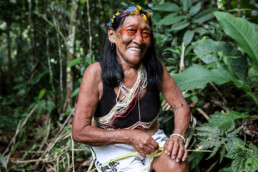
“The forest is rich and provides us with everything we need.We are not poor, we are rich in resources and we will not allow anyone to come and destroy our home because it is our life”
– Awane Ahua, Pekinani (traditional leader)
The northern Ecuadorian Amazon is a tragic example of how the delicate web of life in the rainforest can be ruined within a generation by the arrival of extractive industry. In 1970, the area around Lago Agrio, the region’s biggest city, was one of healthy rivers and forests, full of animal and aquatic life. Now, in villages along the Putamayo and Aguarico, the water is undrinkable and many ancestral hunting grounds are bare, polluted, and bisected by roads. Fragmentation is a major threat to biodversity and wildlife, and the government’s proposed oil blocks would pollute an important biological corridor running across the wider region.
The species-level stakes of Amazon protection were highlighted this May with the release of a landmark United Nations’ report on biodiversity. The report warned that unless critical ecosystems are protected, as many as one million species are threatened with near-term extinction. The Waorani have won a battle for themselves, their children and the planet, but also for the jaguars, the monkeys, the birds, and the ants.
8) Union of Indigenous Nations
The indigenous nations of the Ecuadorian Amazon understand themselves to share a common struggle. Collectively they are the guardians of 70% of the entire Ecuadorian Amazon rainforest. Many of these peoples joined the Waorani in solidarity outside the courtroom, traveling from distant communities in the country’s north and south. They marched with the Waorani in the streets; they submitted amicus briefs; and they returned to their communities to share what they had learned to better organize for the future. “We have united with our Waorani brothers and sisters because we share the same struggle and dream: to protect our forest and to continue being who we are, as indigenous peoples,” said Alex Lucitante, a Kofan leader. “We will continue to unite forces and build strength between our peoples to resist the threats to our territories. Without unity, there can be no triumph.”
"Indigenous Nations across the Amazon and the world must band together to protect our homes."
- Oswando Nenquimo
This model of multi-nation mobilization and solidarity — across Ecuador and the entire Amazon — will be crucial to defeating the extraction at-all-costs paradigm that threatens the region. The Waorani alliance was a powerful demonstration of this. Now the challenge is to scale up the precedent and further empower those defending the seven million acres of indigenous land still targeted by the government and the oil industry.
Will you stand with the Amazon’s oldest guardians to protect a forest we all depend upon at this critical moment?
The Waorani Resistance in Photos
For elders living in Waorani territory of Ecuador’s Pastaza Province, a ½ million acre roadless wilderness still untouched by the perils of oil, mining and logging, the forest contains nearly everything that is needed for a happy and healthy life.
▼ Here, Pava Yeti, an elder from the village of Kiwaro, makes a basket from palm leaves for harvesting and carrying wild fruits, such as petomo (ungurahua) and nontoka (peach palm).
The Waorani people’s knowledge of their tropical rainforest homeland is legendary. In this photograph, Memo Ahua, from the village of Akaro, uses the Winang plant to imitate the shrill whistling sound of a crying-baby-toucan. Tucked under his shoulder is a 3-meter blowgun made from the chonta palm, a black hardwood, wrapped in a fine leathery bark and sealed with beeswax.
Woven together by hundreds of miles of trails that connect birthplaces with burial grounds, gardens with villages, hunting camps with fishing holes, plant medicines with sacred sites, and backwoods creeks with big water rivers, Waorani elders know every nook and cranny of their immense rainforest home.
In the Oil Fields of the Amazon
Further to the east however, decades of oil extraction have converted thousands of acres of ancestral hunting grounds, fruit orchards and sacred sites into a patchwork of oil fields, logging camps, roads, and colonist settlements.
► In this picture, on the edge of Yasuni National Park famous for its rich biodiversity, a family of Waorani from the Via Pindo oil road walk back to their village along pipelines to avoid the hazards of speeding oil-company 18-wheelers.
And further to the north, in the borderlands with Colombia and Peru, more than a half-century of oil operations and colonization has devastated the ancestral lands of the Kofan, Siona and Secoya peoples.
▼ Here, Emergildo Criollo, a Kofan leader, recalls the first time he saw the oil company helicopter arriving in his people’s ancestral land. “Since then, the oil company has brought nothing but sickness and death to our people,” he tells Nemonte Nenquimo, leader of the Waorani people of Pastaza.
In 2012, the Ecuadorian Government announced plans to auction over 7 million acres of indigenous lands in the southcentral amazon to the oil industry.
Included in the oil auction was the newly denominated “Oil Block 22”, a half million acres of primary rainforest that the Waorani have called home for centuries.
Despite a slick government sponsored campaign to promote investment, many oil blocks, including Block 22, were not successfully sold at auction. Oil investors cited “risks” associated with community opposition and unattractive financial terms.
However, for the Waorani the “failed” oil auction was a warning. And a call to organize.
▼ In this photograph, youth leader Oswando Nenquimo reads a message to the Ecuadorian Government:
“We do not recognize what the government calls Oil Block 22. Our forest homeland is not an oil block. It is our life.”
As a strategy of resistance, from 2015-2018, Waorani youth and elders set out to document and demonstrate life in their territory by creating a “living map” of their connection to the land, using GPS, film, camera traps, drones, and a customized mapping program that allowed them to work offline in remote forest.
Whereas the maps of oil companies only show petroleum deposits and major rivers, the maps that the Waorani created tell the story of their people’s relationship with the plants, the trees, the water, and the animals.
▼ Their maps identify historic battle sites, ancient cave-carvings, jaguar trails, medicinal plants, animal reproductive zones, important fishing holes, creek-crossings, and sacred waterfalls.
▼ In this photograph, school kids in the village of Nemonpare display their drawings of what they like most about life in the forest.
In 2018, the Ecuadorian Government announced renewed plans to auction million of acres of the southcentral Amazon to the oil industry.
In a series of urgent region-wide assemblies the Waorani decided to take legal action to halt the sale of their lands.
▼ In a public hearing in the village of Nemonpare, the Ecuadorian Human Rights Ombudsman takes testimony from youth and elders in preparation for the lawsuit.
Dozens of hours of interviews revealed that the government’s “consultation process” relied on time-tested tactics of manipulation and deceit, and was designed to keep Waorani villagers in the dark about the potential impacts of oil operations in their territories.
“The government came to our village for an hour and promised us hospitals and schools. We didn’t know that they were planning on selling our land to the oil companies.”
− Wina Boyotai from Kiwaro ►
“For the government, the sale of our land was a foregone conclusion. They had already drawn up the plans and the maps. They didn’t come to consult us. They came to trick our people into signing a piece of paper. But we know we have rights, and we are ready to defend them.”
− Oswando Nenquimo from Nemonpare ►
Victory for the Waorani
On February 27, 2019, hundreds of Waorani villagers from “Oil Block 22” marched to the courthouse in the Amazonian frontier town of Puyo to file their landmark lawsuit against the Ecuadorian government. ►
▲ In the courthouse building, the lead plaintiffs wait to file their landmark lawsuit. From left to right, Memo, Omanka, Nemonte, Wina, and Dika.
THE VERDICT IS IN! VICTORY FOR THE WAORANI PEOPLE!
Back to the Forest
After the historic court ruling which protects a half-million acres of their ancestral land from oil drilling, the Waorani returned to their forest homes.
And walked freely in their forest.

The Waorani’s landmark legal victory protects their ancestral homeland from oil and sets a powerful precedent for other indigenous nations to do the same, but this watershed moment could be snatched away in the next two months by a legal appeal. The Ecuadorian judicial system is not immune to political influence, especially with millions of acres of “untapped oil reserves” at stake and the Government’s keen interest in undoing this powerful legal precedent for indigenous rights.
We must seize the momentum, and turn national and global attention into an even bigger victory for indigenous peoples, the Amazon and our climate.
Here’s what you can do today:
For elders living in Waorani territory of Ecuador’s Pastaza Province, a ½ million acre roadless wilderness still untouched by the perils of oil, mining and logging, the forest contains nearly everything that is needed for a happy and healthy life.
▼ Here, Pava Yeti, an elder from the village of Kiwaro, makes a basket from palm leaves for harvesting and carrying wild fruits, such as petomo (ungurahua) and nontoka (peach palm).
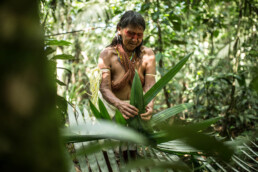
The Waorani people’s knowledge of their tropical rainforest homeland is legendary. ▼ In this photograph, Memo Ahua, from the village of Akaro, uses the Winang plant to imitate the shrill whistling sound of a crying-baby-toucan. Tucked under his shoulder is a 3-meter blowgun made from the chonta palm, a black hardwood, wrapped in a fine leathery bark and sealed with beeswax.

Woven together by hundreds of miles of trails that connect birthplaces with burial grounds, gardens with villages, hunting camps with fishing holes, plant medicines with sacred sites, and backwoods creeks with big water rivers, Waorani elders know every nook and cranny of their immense rainforest home.

In the Oil Fields of the Amazon
Further to the east however, decades of oil extraction have converted thousands of acres of ancestral hunting grounds, fruit orchards and sacred sites into a patchwork of oil fields, logging camps, roads, and colonist settlements. ▼ In this picture, on the edge of Yasuni National Park famous for its rich biodiversity, a family of Waorani from the Via Pindo oil road walk back to their village along pipelines to avoid the hazards of speeding oil-company 18-wheelers.

And further to the north, in the borderlands with Colombia and Peru, more than a half-century of oil operations and colonization has devastated the ancestral lands of the Kofan, Siona and Secoya peoples.
▼ Here, Emergildo Criollo, a Kofan leader, recalls the first time he saw the oil company helicopter arriving in his people’s ancestral land. “Since then, the oil company has brought nothing but sickness and death to our people,” he tells Nemonte Nenquimo, leader of the Waorani people of Pastaza.

▼ In these photographs, Waorani youth and elders visit the oil fields of Lago Agrio to learn firsthand from the Kofan, Siona and Secoya about the impacts of the oil industry.
Upon arriving at an oil platform outside the industry town of Shushufindi in Ecuador’s Amazon Waorani women sing to the oil well: “We walk lightly in the footsteps of our ancestors, we will not let you into our land.”

In 2012, the Ecuadorian Government announced plans to auction over 7 million acres of indigenous lands in the southcentral amazon to the oil industry.
Included in the oil auction was the newly denominated “Oil Block 22”, a half million acres of primary rainforest that the Waorani have called home for centuries.

Despite a slick government sponsored campaign to promote investment, many oil blocks, including Block 22, were not successfully sold at auction. Oil investors cited “risks” associated with community opposition and unattractive financial terms.
However, for the Waorani the “failed” oil auction was a warning. And a call to organize.

▼ Here, Omene Iwa, from the community of Tzapino tells how his ancestors defended the land with spears. For Waorani elders, the current threats are too great to confront with spears alone, and so the youth must find new ways to defend their territory against unrelenting global pressures.

▼ In this photograph, youth leader Oswando Nenquimo reads a message to the Ecuadorian Government: “We do not recognize what the government calls Oil Block 22. Our forest homeland is not an oil block. It is our life.”

As a strategy of resistance, from 2015-2018, Waorani youth and elders set out to document and demonstrate life in their territory by creating a “living map” of their connection to the land, using GPS, film, camera traps, drones, and a customized mapping program that allowed them to work offline in remote forest.
Whereas the maps of oil companies only show petroleum deposits and major rivers, the maps that the Waorani created tell the story of their people’s relationship with the plants, the trees, the water, and the animals.
▼ Their maps identify historic battle sites, ancient cave-carvings, jaguar trails, medicinal plants, animal reproductive zones, important fishing holes, creek-crossings, and sacred waterfalls.
▼ In this photograph, school kids in the village of Nemonpare display their drawings of what they like most about life in the forest.

In 2018, the Ecuadorian Government announced renewed plans to auction million of acres of the southcentral Amazon to the oil industry.
▼ Here is a map illustrating the 16 proposed oil concessions, and their overlap with the ancestral territories of 7 indigenous nations.

“Oil Block 22” was once again up for sale to the highest petrol company bidder.
In a series of urgent region-wide assemblies the Waorani decided to take legal action to halt the sale of their lands.

▼ In a public hearing in the village of Nemonpare, the Ecuadorian Human Rights Ombudsman takes testimony from youth and elders in preparation for the lawsuit.

Dozens of hours of interviews revealed that the government’s “consultation process” relied on time-tested tactics of manipulation and deceit, and was designed to keep Waorani villagers in the dark about the potential impacts of oil operations in their territories.
“The government came to our village for an hour and promised us hospitals and schools. We didn’t know that they were planning on selling our land to the oil companies.” − Wina Boyotai from Kiwaro ▼

“For the government, the sale of our land was a foregone conclusion. They had already drawn up the plans and the maps. They didn’t come to consult us. They came to trick our people into signing a piece of paper. But we know we have rights, and we are ready to defend them.” − Oswando Nenquimo from Nemonpare ▼

▼ Here, in the community of Nemonpare along the Curaray river, villagers prepare banners to take to the city to defend their rights and make their voices heard.
Victory for the Waorani
▼ On February 27, 2019, hundreds of Waorani villagers from “Oil Block 22” marched to the courthouse in the Amazonian frontier town of Puyo to file their landmark lawsuit against the Ecuadorian government.

▼ In these photographs, Waorani women lead the march to the courthouse.
Many indigenous peoples from across the Amazon traveled to support the Waorani peoples’ historic fight to protect their lands from oil drilling. ▼
▼ In this picture, Nemonte Nenquimo, President of the Waorani Organization of Pastaza, carries the lawsuit in her hands, as Amazon Frontlines lawyer, Maria Espinosa addresses a crowd of supporters.

▼ In the courthouse building, the lead plaintiffs wait to file their landmark lawsuit. From left to right, Memo, Omanka, Nemonte, Wina, and Dika.

▼ In these photographs, the Waorani enter the courtroom to face off with the Ministry of Hydrocarbons, the Ministry of Non-Renewable Resources, and the Ministry of the Environment. Photography was not permitted during the court proceedings.
▼ On April 26th, just hours before the landmark verdict in the Waorani trial was announced, Nemonte Nenquimo addresses a crowd of supporters and media on the front steps of the courthouse. “No matter what the court says today we will not let oil in our lands. Our land is not for sale!”

THE VERDICT IS IN! VICTORY FOR THE WAORANI PEOPLE!

▼ Here Nemonte Nenquimo shares details of the historic verdict at a press conference outside the courthouse. The three-judge panel ruled that the Ecuadorian government had violated the Waorani’s rights to prior consultation and self-determination.

▼ In these photographs, the Waorani joyously march through the streets of the Amazonian town of Puyo during a torrential downpour. The court’s ruling immediately halts the government’s plans to sell their land to the oil industry, and sets a precedent for other indigenous nations to do the same.
Back to the Forest
After the historic court ruling which protects a half-million acres of their ancestral land from oil drilling, the Waorani returned to their forest homes.

And drank from the freshwater creeks.

And enjoyed the beauty of the waterfalls.
And walked freely in their forest.


The Waorani’s landmark legal victory protects their ancestral homeland from oil and sets a powerful precedent for other indigenous nations to do the same, but this watershed moment could be snatched away in the next two months by a legal appeal. The Ecuadorian judicial system is not immune to political influence, especially with millions of acres of “untapped oil reserves” at stake and the Government’s keen interest in undoing this powerful legal precedent for indigenous rights.
We must seize the momentum, and turn national and global attention into an even bigger victory for indigenous peoples, the Amazon and our climate.
Here’s what you can do today:
